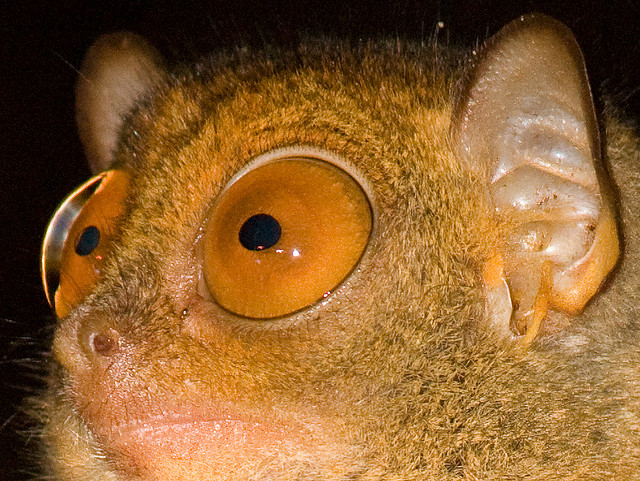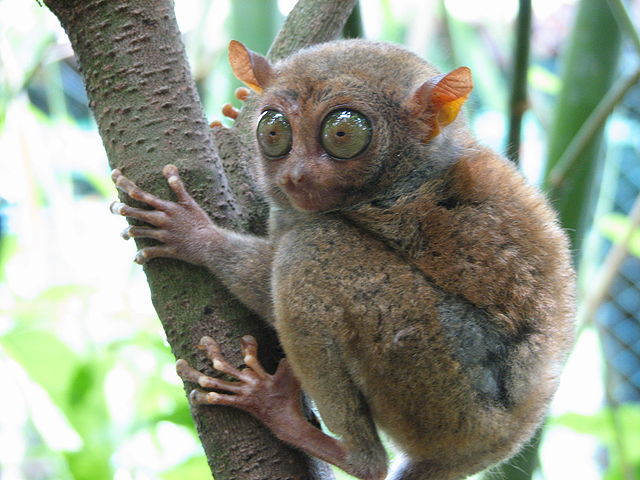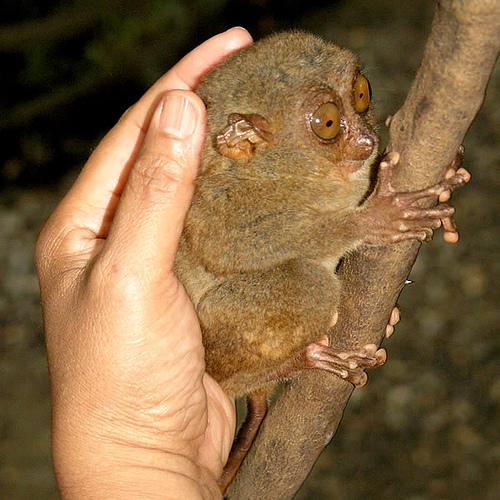Some Fun Facts About the Philippine Tarsier
The Tarsier, pronounced “tar-see-ay,” is an adorable little guy. Just look at those eyes! They make me melt with affection. One of my readers recently asked me if I would do a write up about tarsiers, so I’ve done some research and put together some fun facts about the Philippine Tarsier. Make sure you watch the video. It is entertaining, I promise. 🙂 Enjoy!
zefrank1 – Published on Jan 24, 2013
Fun Facts About the Philippine Tarsier’s Eyes
- The tarsier has enormous eyes and acute eyesight, excellent night vision, and may be able to see ultraviolet light.
- The tarsier’s eyes are the largest of any mammal relative to body size. If our human eyes were the same size relatively, they would be the size of grapefruits.
- The tarsier’s eyes are fixed to his skull and don’t turn in their sockets. Therefore, the tarsier can rotate his head 180 degrees, just like an owl, to see all the way around.
- Each eyeball is approximately 16 mm in diameter and is as large as its entire brain.
- Unlike many nocturnal vertebrates, tarsiers lack a light-reflecting area (tapetum lucidum) of the eye and have a fovea.

Fun Facts About the Philippine Tarsier Senses
- Tariers have an incredibly strong auditory sense because their auditory cortex is very distinct.
- Philippine tarsiers are capable of hearing frequencies as high as 91 kHz. They are also capable of vocalizations with a dominant frequency of 70 kHz.
Fun Facts About the Philippine Tarsier Body
- The head and body range from 4 to 6 inches (10 to 15 cm) long, but the hind limbs are about twice this long (including the feet), and they also have a slender tail from 8 to 10 inches (20 to 25 cm) long.
- Their fingers are also very long, with the third finger being about the same length as the upper arm.
- Most of the digits have nails, but the second and third toes of the hind feet bear claws instead, which are used for grooming.
- Tarsiers have very soft, velvety fur, which is generally buff, beige, or ochre in color.

Fun Facts About the Philippine Tarsier Behavior
- Tarsiers are the only extant entirely carnivorous primates: they are primarily insectivorous, and catch insects by jumping at them. They are also known to prey on birds, snakes, lizards, and bats.
- All tarsier species are nocturnal in their habits, but like many nocturnal organisms, some tarsiers may show more or less activity during the daytime.
- Tarsiers tend to be extremely shy.
Fun Facts About the Philippine Tarsier Reproduction
- Gestation takes about six months
- Tarsiers give birth to single offspring.
- Young tarsiers are born furred, and with open eyes, and are able to climb within a day of birth.
- Tarsiers reach sexual maturity by the end of their second year.
Conservation
The conservation status of all tarsiers is vulnerable to extinction. Tarsiers are a conservation-dependent species meaning that they need to have more and improved management of protected habitats or they will definitely become extinct in the future.
Tarsiers have never formed successful breeding colonies in captivity. This may be partly due to their special feeding requirements.
A sanctuary near the town of Corella, on the Philippine island of Bohol, is having some success restoring tarsier populations. The Philippines Tarsier Foundation (PTFI) has developed a large, semiwild enclosure known as the Tarsier Research and Development Center. Carlito Pizarras, also known as the “Tarsier man”, founded this sanctuary where visitors can watch tarsiers up close in the wild (naturally without touching them). The trees in the sanctuary are populated with nocturnal insects that make up the tarsier’s diet.

Some Fun Facts About the Philippine Tarsier
I told you he is adorable! Was I right?
********
Some Fun Facts About the Philippine Tarsier, #wildlife #RETWEET Click To Tweet
************
I hope you have enjoyed, “Fun Facts About the Philippine Tarsier“
You might also like: Sloths Being Cute, They Just Can’t Help Themselves
♥♥♥♥♥
MY QUESTION FOR YOU TODAY: Are there any animals you know of that you would like to see featured here on my blog? Is there any creature that you would like to learn more about? Or, do you have a story you would like to submit about a pet you have? I would love to hear from you in the comment section below, or please email me directly at jeanne@animalbliss.com
*************************
*** Please leave a comment below and remember to share. ***
It’s just sexy!
As always, thank you for taking the time to visit my blog!

♥ PEACE ♥
- Mindful Travel With Your Dog This Holiday Season - December 23, 2019
- A-Z of Australia’s Endangered Wildlife - December 20, 2019
- Teaching Your Kids How to Walk the Dog Safely - December 2, 2019

Thank you for a Nice video!!!! These cute species are amazing!
Thank you for visiting Animal Bliss, Divina.
yes, this tarsier is so adorable. haven’t seen one in real though but am hoping someday to even touch one ;-D.. such a wonderful creature.
That was a good video, lol. They look so soft and also kind of creepy. You think they are prone to eye injuries?!
They are a little funny looking, I agree. You would think that they’d be prone to eye injury, but I’ll bet their impulses are pretty fast. Thanks for taking the time to have a look at the video, Kayla. I really enjoy that narrator. He’s amusing. 🙂
Looks like a small monkey. So cute!!
Hahaha love the video, its pretty entertaining.
I love the video too. The narrator is comical. Yes, it does look like a little monkey, doesn’t it? So cute. Thanks for stopping by, Anne. I appreciate you!
Wow! The brain is as large as the eye, Amazing on how this small tarsier can do with those eyes.
Cute little thing, isn’t it, Manu?
This animal is so amusing, it doesn’t look real! It looks like a made-up creature from a Disney movie, especially with those huge eyes! I’ve enjoyed learning about an animal that I knew nothing about.
Thanks, Amy. I’m glad you enjoyed learning about this animal. My mission is complete! 🙂
That video was HELLA entertaining! lol Geesh, looks like those eyes are about to pop out of its head!
Glad you liked the video too, Bennie. I just love those eyes. Talk later!
I never cease to be amazed at the vast variety in the animal world – this little guy is incredible! Thanks for sharing!
I’m amazed too at the variety of animals in the world. They fascinate me and I enjoy bring them to the attention of my readers. Thanks so much for stopping by! I appreciate you!